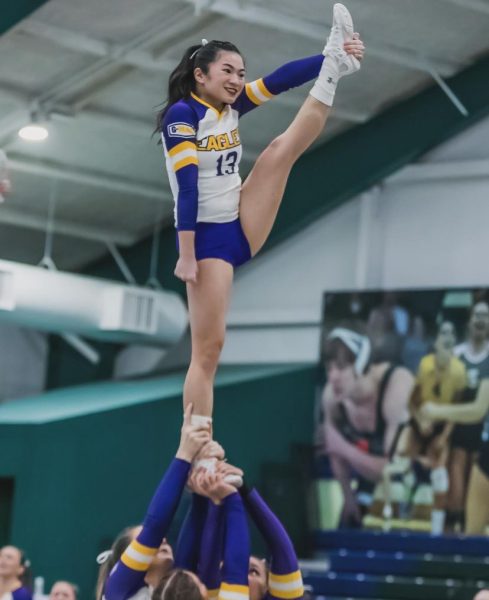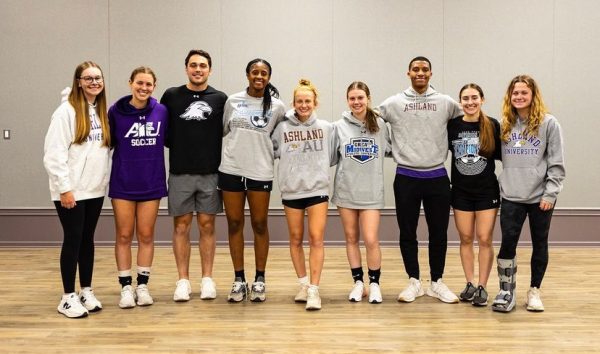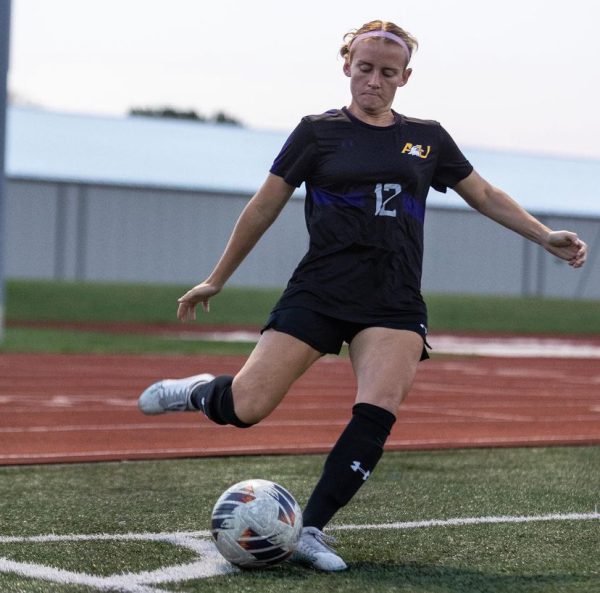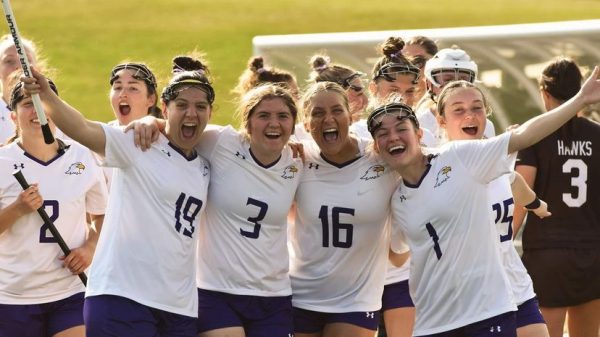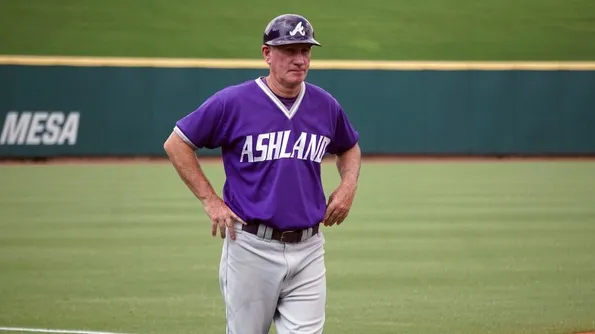Lights, cameras, fire and swimming
August 22, 2012
I had convinced myself that it would be like going to the Super Bowl. It wasn’t. It was better. It was like playing in the Super Bowl.
Even in my wildest dreams, I didn’t have any idea of what to expect when I arrived at the CenturyLink Center in Omaha, Neb., the site of the 2012 Olympic Swimming Team Trials. I’d read all of the handouts, guides and waivers online, seen the facility layout on two-color maps and even watched the same event in the same venue four years earlier on NBC.
I still had no idea what I was getting myself into.
In the weeks before I left, I talked to a lot of the people about the Trials. Friends, family, fellow swimmers and parents and even local reporters asked what I was looking forward to most about the meet. I dwelled on answering that question.
I decided that the best part would be having a free ticket to watch the fastest swim meet in the world in-person and for free.
I thought about how great it would be to see all the athletes I look up to like celebrities. I follow them on Twitter and even creep on Facebook sometimes. I viewed myself as a fan.
I have actually seen most of these swimming celebrities at other meets that I’ve been to—meets that I have participated in. I’ve practiced with a few of them and had casual conversations on deck with others. In hindsight, I realized something: my urge to be a swim fan instead of a swimmer reflected upon the internal belief that I didn’t belong at the meet. That I got lucky or something and that’s why I was in the car on the way to Omaha.
I am the same as them. They change in the same locker rooms as I do (or, on the same pool deck—we are very lazy, and we’ll change with the privacy of only a towel to avoid the long, cold walk to the locker rooms). They warm up right next to me in the warm-up pool. They walk in the same entrances and out the same exits.
Free food? Yes, please.
Two pools were set up in the facility for Trials. In addition to the competition pool set up inside of the arena, there was a second warm-down pool built in a hall of the convention center, about 50 meters away from the steps leading to the arena pool.
Around the warm-down pool were places where athletes could eat, drink, play video games and get a massage, all for free. The meet is set up to ensure that athletes can compete at the very highest level, which is why the pre- and post-race snacks and recovery products—everything from animal crackers to chocolate milk, smoothies to Greek yogurt—are provided.
Athlete hospitality had couches and beanbags for athletes to relax during down time, watch TV, charge a phone, listen to music, and even play with an Xbox Kinect or one of a few iPads.
Unlike most swim meets that tend to be three or four days long, Trials is eight days long. The majority of swimmers only have one or two swims during that period, which leaves a lot of athletes without a lot to do.
All of the lights
I was one of those swimmers. My only race, in the preliminaries of the 100-meter breaststroke, was on the first day of competition. I also time trialed the 100-meter butterfly on day three, but that still left me without swims for the final four days that we were in Omaha.
I’m glad it worked out that way.
Usually, I have a trouble coping with my nerves during competition; they often become a major distractor. My swim at Trials was different, though. Even though it was the biggest stage I had ever competed on, even though the lights were brighter and there were more fans than I could have even imagined, I wasn’t nervous. I was just happy.
Without the nerves, I was relaxed. I actually had fun in the minutes leading up to when they walked my heat out behind the blocks for the start of the race. That never, ever happens.
This made for a great racing environment. I came into the meet as the 89th-fastest qualifier. I finished in 90th place, adding .48 seconds to finish in 1:04.78 and join the almost 80 percent of other swims at the meet which were slower than the seed time. I was out in the first 50 meters almost a second faster than my qualifying time from last summer, but I didn’t have the same acceleration in the final 35 meters as I did last year.
Still, chalk it up as a successful swim.
The 100 fly time trial was an even more successful swim. I shattered my personal best by .73 seconds, touching the wall in 56.71 seconds.
Life in the stands
If this meet is a virtual who’s who of swimming, I am one of those whos. I was one of the 1,800-plus athletes at the meet; one of the 0.6 percent of all USA Swimming members fast enough to qualify. And like about 1,700 of the other athletes, I knew that I didn’t have a shot at being one of the top-2. Only about 2 percent of us qualify for the Games.
If you consider that another 3 percent might have legitimate chances at making the team, That leaves the other 95 percent with something other than swimming on their mind.
You’ll never see it on TV, but most of the athletes spent their time in and around the warm-down pool. Media aren’t allowed in; the only people credentialed are athletes, coaches and support staff.
Understandably, athletes quickly established areas around the pool. Cal-Berkeley set up on top of some wrestling mats that were dragged in, Texas and Auburn preferred a large spot on the floor and Virginia and Ohio State took over areas of seating that were temporarily removed from the arena to make room for the temporary pool set up there. Some others congregated around the warm-down pool. Only a few occupied the athlete section inside of the arena.
That warm-down pool was popular because of its environment. In contrast to a smaller-scale meet where athletes take over bleachers on a pool’s deck, this pool was away from the meet entirely. Aside from the big screens next to the pool showing a duplicate of the arena scoreboard and the live feed from the meet, a few other TVs around the pool were the only connection to the meet.
It was relaxing and carefree. There were no coaches whistling or motioning to get a swimmer to pick up the tempo, no athletes and fans cheering. There was just the subtle splashing of the water in the pool above and the sounds of chatter. You can just hang out.
The social perspective
At its very core, Trials functions more as a social event than an athletic one. It is one of the few times when post-grad, collegiate and interscholastic athletes all come together, and it is the only time when a gathering this large lasts for eight days.
It’s a good chance to make some new friends and catch up with older ones.
Oh, and if you don’t have a team of your own, making new friends is a MUST if you hoped to get a seat inside the arena to watch finals. Seats were unassigned and outnumbered by the athletes at the meet.
I was lucky. The first night of the meet, I essentially walked into the middle of Texas A&M’s saved seats. I’m almost positive that their kindness was the only thing that kept them from asking me to leave.
I ended up spending the first three nights of the meet with A&M, a virtual adoptee.
There are a lot of storylines at meet of this caliber. For a large number of athletes, this is their career’s final resting place. Others hope it will not be the end of theirs. Some are trying to come onto the scene. Some are trying to come back.
There’s no place better to appreciate this shift of power than with a moving swimmer’s team. A&M’s Breeja Larson was one of the swimmers on her way up at a rapid rate.
After she won the 100-meter breaststroke, upsetting world champion Rebecca Soni in the process, the media played on her storyline. How it was the first time she had tapered for a long course meet. How she only started swimming late in high school.
I noticed a different storyline, though. I noticed how Larson was just one piece of A&M’s virtually vicarious women’s team. During the final 50 meters of that 100 breast final, I don’t think there was a single moment where any of her teammates feet were all on the ground at the same time. As she continued to move up in the final 10 meters, her teammates overwhelmed me with screaming. And when she won, punching her ticket to the Olympic Games, they were all on deck before Larson could even get out of the pool. They congratulated her and hugged her and cried with her. I’ve never seen more people happier before in my life.
This was my favorite story of the meet. This is how strong the power of a team is in what’s generally considered only an “individual” sport.
Onward?
Understandably, I was jealous that I didn’t have a team. While it’s cool to be able to say, “I’m the first person from my school to make it to Olympic Trials,” it also sucks.
Trials is a wonderful experience, let me reiterate that; but, an experience is more rewarding if it’s a shared experience. I won’t ever be able to look back in old age, open up Facebook chat and ask someone, “Remember that time when we tried out for the Olympic team?”
Towards the end of the week, more and more swimmers got out of the water for the final time, after what was their final race. This meet lends itself well to retirement, to finality. And, unlike other ends aren’t as gratifying, most retiring swimmers can know for certain that this was the right time. That they went out on top.
This confused me, to say the least. I wasn’t done, nor did I want to be. I’m not at the top right now. I can do more.
I might feel the same way next year after NCAAs (assuming that next season is as successful as I’m hoping it will be). I do know that I want my ending—like most things in my life—to be perfect.
I’ve already thought about what I would do different if I had another chance at Trials. 2016 could be that other chance. That would, of course, mean swimming for another three years after college; not unheard of, not really even that out-of-the-ordinary. Maybe I can keep getting better. Maybe I can bring a team up with me. Maybe, just maybe, I can find that perfect, happy ending.



